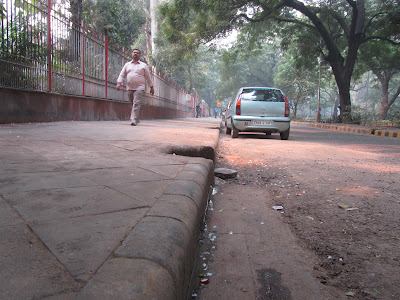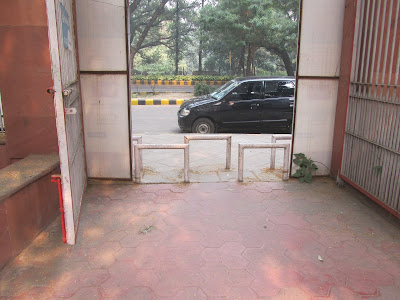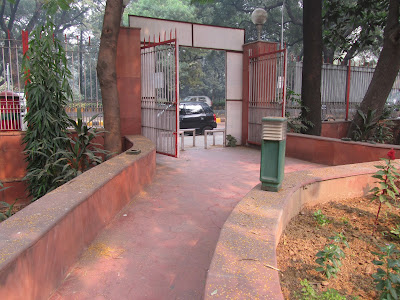Dear Colleagues,
It is painful that in Delhi, the access is still a matter of advocacy, cajoling, recommendations despite a CPWD Manual of 1998, Chief Commissioner's guidelines of 2001 and National Building Code 2005. Today, most public buildings of the Government, Banks- whether public sector or private, schools - both private and public, post offices, Pension offices, Dispensaries, ATMs, Bus stations, Pedestrian pathways, intersections, markets, cinema halls, para transit vehicles, continue to remain inaccessible for persons with disabilities in clear breach of the legal mandate!
Reason... no time frame in the law and no penalty for not ensuring accessibility and on top of it the tags like "within the limits of their economic capacity" that are found in the Disabilities Act of 1995 which otherwise can not be used given the huge sums lying with the authorities for the purpose.
All flyovers that have been created or are being created in the name of providing signal free arterial roads like inner ring road (Mahatma Gandhi Marg), outer ring road, make no provision for the pedestrians to cross over to the other side more particularly those provided at Dhaula Kuan Flyover, AIIMS Flyover & Mool Chand Flyover etc. The pedestrians including those with disabilities are forced to come in conflict with the moving traffic in absence of accessible pedestrian crossovers. Government's ever road widening spree has made roads dangerous for pedestrians and it fails to address the congestion and pollution.
Most pedestrian underpasses, foot-over bridges make no efforts to assimilate those living with reduced mobility. Wherever, some relief is provided in terms of accessibility it is usurped by parking mafia, encroachments and a bad civic sense. Is this the city or community do we want?
What we need today is deadlines and strict enforcement. Failures in achieving the deadline must meet a financial penalty on the responsible officials/ department. The guidelines on the Barrier Free Environment must be implemented by all departments and especially the civic agencies under whose domain the most public infrastructure is.
Our Social Welfare Minister has made an effort through her letter to all the departments of Delhi Government to ensure that guidelines are implemented properly but I see even here there is no deadline. The advisories don't work in the political system unless there is accountability for the continued defiance.
It is the time that we no longer state "problems faced by persons with disabilities" as reasons for providing accessibility. This must become a part of DNA of the Civil Agencies to plan and execute projects that are based on universal design. No more benefits in percentages that often seem to work counter productive. It has to be borne in mind that an accessible environment is beneficial and friendly to every body hence this is a requirement for every one and not just the disabled.
Here is the coverage from Times of India today: Follow Advisory for Disabled: Walia
Follow Advisory for Disabled: Walia
Naziya Alvi Rahman / TNN / Feb 5, 2013
NEW DELHI: To make city roads and buildings disabled friendly, social welfare minister Kiran Walia has asked all government agencies involved in construction of roads and buildings to consult the manual ‘Planning a Barrier Free Environment’ compiled by the office of chief commissioner for persons with disabilities.
In a letter sent in January, Walia has also directed PWD, local bodies, DSIIDC etc to implement the recommendations in the existing buildings. “I am writing to you to bring to your notice the difficulties being faced by the disabled persons in accessing schools, banks, shopping complexes, Metro stations and ATMs,” stated the letter. “The concerned engineers could be given proper guidance for planning a barrier-free environment as per the recommendations in the manual, a copy of which has already been sent to you,” it added.
In the Disability Act 1995, the civic bodies have been directed to implement the measures suggested in the manual “within the limits of their economic capacity”.
Sources said Walia took up the issue after she came across a report highlighting plight of a boy who struggled for hours to take his disabled father from the entry point of a railway station to the platform. “I called several meetings and toured campuses and public buildings. We found that most public buildings lack disabled-friendly measures. Also while our buses and bus stops have been designed in disabled-friendly way, our pavements are not. Therefore, we have made an attempt to divert the attention of civic authorities towards city buildings, roads etc,” said Walia.
The social welfare department also directed the chief commissioner to ensure the implementation of the measures and follow it up regularly. The manual, which was compiled with the help of Indian Spinal Injuries Centre experts, has been out since 2001 but the city has hardly seen any implementation of its recommendations.










